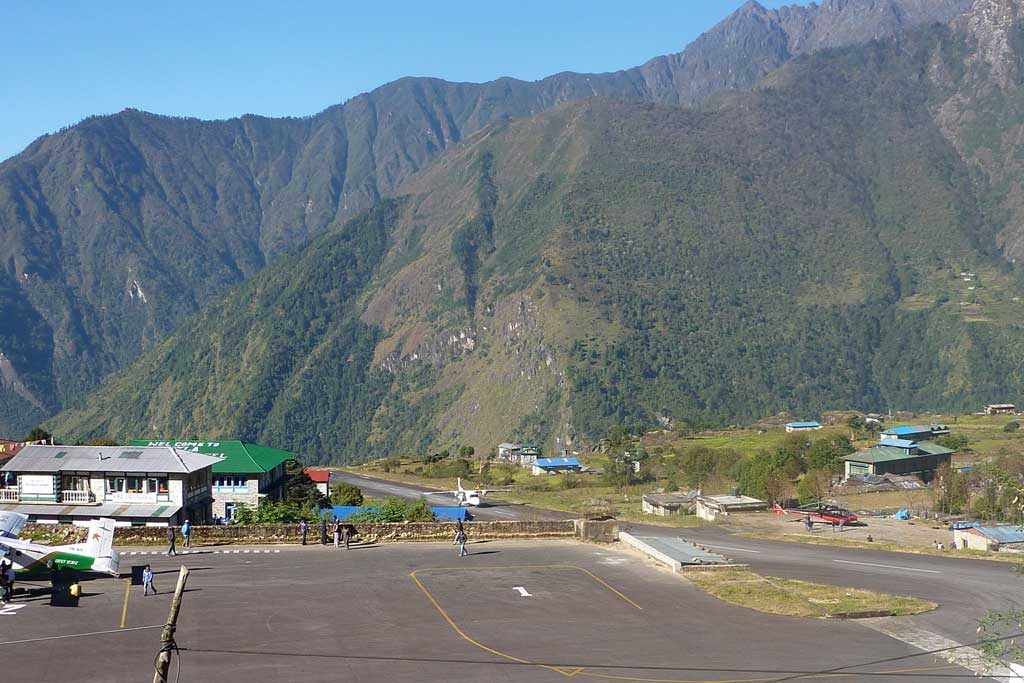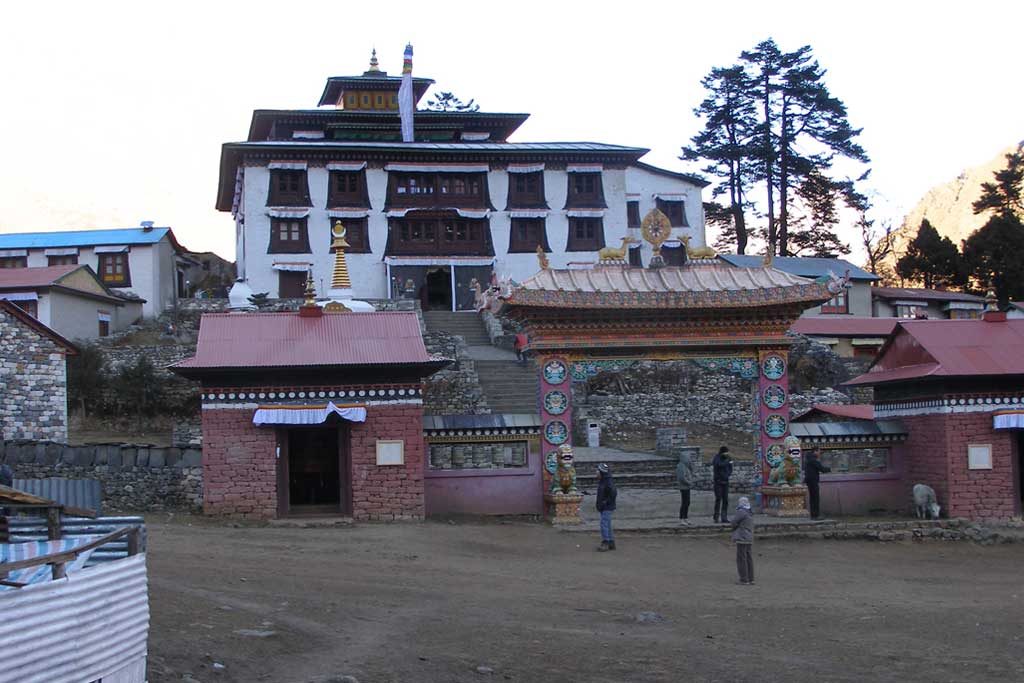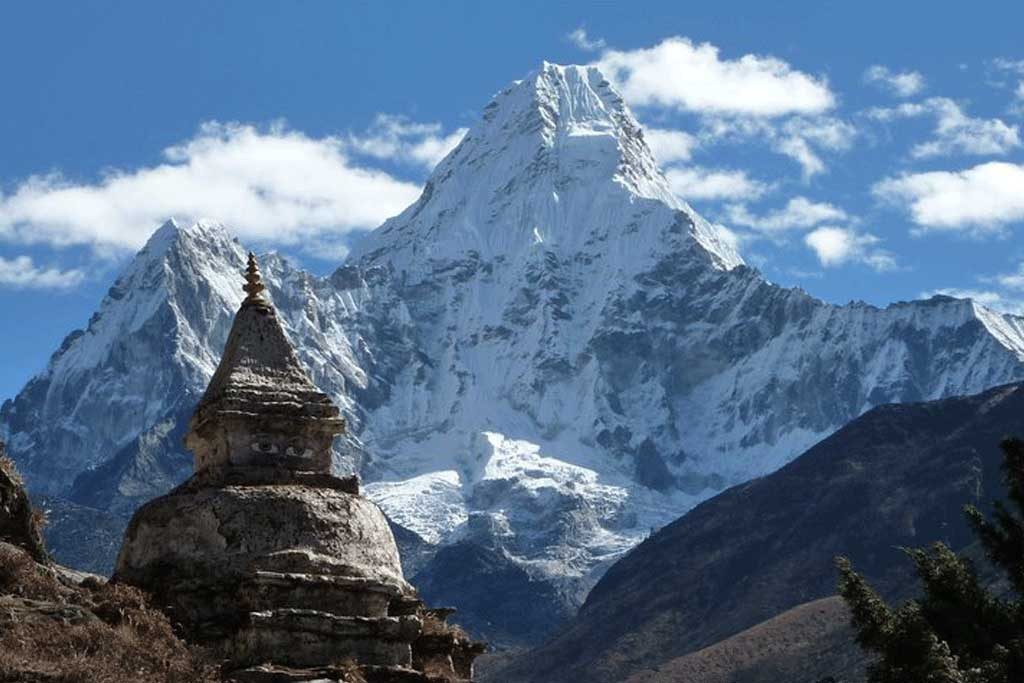Have you ever thought of the highest point or place on the earth?
Yes, it is of course Mount Everest of Nepal. There are two ways getting there. A gradual walk from Lukla to Base Camp and trek back through the same trail for 12-14 days. Another shortest way is taking the Everest Helicopter Tour with landing opportunities at Base Camp that completes in 5-6 hours in the morning from Kathmandu airport.
==>> How much Calories do I burn from Everest Base Camp Trek? Answer is available at Hike for Health
JOIN OUR FIXED DEPARTURE
| START DATE | FINISH DATE | COST (USD) | SPACE LEFT |
|---|---|---|---|
| 3 March 2024 | 16 March 2024 | $1440 | 8 |
| 10 March 2024 | 23 March 2024 | $1440 | 8 |
| 17 March 2024 | 30 March 2024 | $1440 | 8 |
| 24 March 2024 | 6 April 2024 | $1440 | 8 |
| 31 March 2024 | 13 April 2024 | $1440 | 8 |
| 2 April 2024 | 15 April 2024 | $1440 | 8 |
| 7 April 2024 | 20 April 2024 | $1440 | 8 |
| 14 April 2024 | 27 April 2024 | $1440 | 8 |
| 21 April 2024 | 4 May 2024 | $1440 | 8 |
| 28 April 2024 | 11 May 2024 | $1440 | 8 |
| 1 May 2024 | 14 May 2024 | $1440 | 8 |
| 5 May 2024 | 18 May 2024 | $1440 | 8 |
| 12 May 2024 | 25 May 2024 | $1440 | 8 |
| 19 May 2024 | 1 June 2024 | $1440 | 8 |
| 26 May 2024 | 8 June 2024 | $1440 | 8 |
| 30 May 2024 | 12 June 2024 | $1440 | 8 |
| 2 June 2024 | 15 June 2024 | $1440 | 8 |
| 9 June 2024 | 22 June 2024 | $1440 | 8 |
| 16 June 2024 | 29 June 2024 | $1440 | 8 |
| 23 June 2024 | 6 July 2024 | $1440 | 8 |
| 30 June 2024 | 13 July 2024 | $1440 | 8 |
| 18 August 2024 | 31 August 2024 | $1440 | 8 |
| 25 August 2024 | 7 September 2024 | $1440 | 8 |
| 1 September 2024 | 14 September 2024 | $1440 | 8 |
| 8 September 2024 | 21 September 2024 | $1440 | 8 |
| 15 September 2024 | 28 September 2024 | $1440 | 8 |
| 22 September 2024 | 5 October 2024 | $1440 | 8 |
| 29 September 2024 | 12 October 2024 | $1440 | 8 |
| 6 October 2024 | 19 October 2024 | $1440 | 8 |
| 13 October 2024 | 26 October 2024 | $1440 | 8 |
| 20 October 2024 | 2 November 2024 | $1440 | 8 |
| 27 October 2024 | 9 November 2024 | $1440 | 8 |
| 3 November 2024 | 16 November 2024 | $1440 | 8 |
| 10 November 2024 | 23 November 2024 | $1440 | 8 |
| 17 November 2024 | 30 November 2024 | $1440 | 8 |
| 24 November 2024 | 7 December 2024 | $1440 | 8 |
| 29 November 2024 | 12 December 2024 | $1440 | 8 |
| 1 December 2024 | 14 December 2024 | $1440 | 8 |
| 8 December 2024 | 21 December 2024 | $1440 | 8 |
| 15 December 2024 | 28 December 2024 | $1440 | 8 |
| 22 December 2024 | 4 January 2025 | $1440 | 8 |
| 29 December 2024 | 11 January 2025 | $1440 | 8 |
| 31 December 2024 | 13 January 2025 | $1440 | 8 |
Note: Private trips are available at your preferred dates throughout the year.
Introduction to Everest Base Camp Trail
Mount Everest is the highest peak in the world with an altitude of 8,848 meters. This famous mountain lies on the border of Nepal and Tibet (China). ‘Sagarmatha’ is the Nepalese name of Mt. Everest and Tibetans call this peak ‘Chomolungma’. Everest Base Camp trek is the most popular sought after treks all over the world.
The entire Everest region comes within the boundaries of the Sagarmatha National Park. The Park has a large composition of rugged terrain and gorges of the high Himalayas. It ranges from 2,845 meters further to the top of the world’s highest mountain- Mt. Everest. People believe this to be the home of Yeti, the snow man- an ongoing unsolved mystery!
Mount Everest trekking starts at Lukla, reached by a 35-minute hair-raising flight. Hiking to Everest Base Camp goes along the Dudh Koshi Valley leading into the popular Sherpa hometown- Namche Bazaar and finally the Kalapatthar, foot of Mt. Everest.
Namche Bazaar serves as a central hub of the area for food, sundries, communications and climbing gears. Many trekkers spend a full day in Namche Bazaar for acclimatization. The trail passes then through the famous Tengboche Monastery, Lobuche and finally Gorakshep (5,140m/16,864ft).
Gorakshep is the highest point of accommodation available to the Everest Base Camp visitors. Trekkers also ascend to Kalapatthar (5,545m/18,192ft) for the magnificent views of the Himalayan giants. Trekking in the Himalaya has been the leading activity for adventure travellers in Nepal.
There were several attempts made in the history to achieve a summit over the Mt. Everest. But the first successful expedition became possible only on 29 of May, 1953. Notably, Sir Edmund Hillary and Tenzing Norgay Sherpa led the expedition team.
Brief Itinerary:
| Day | Route | Altitude | Duration |
|---|---|---|---|
| 01 | Arrival in Kathmandu | 1,350m/4,430ft | Free time |
| 02 | Kathmandu City Tour | 1,350m/4,430ft | Tour: 5-6 hrs |
| 03 | Fly Kathmandu to Lukla and trek to Phakding | 2,610m/8,563ft | Fly: 35 minutes, Trek: 3-4 hrs |
| 04 | Trek Phakding to Namche Bazaar | 3,446m/11,306ft | Trek: 5-6 hrs |
| 05 | Rest for acclimatisation in Namche Bazaar | 3,446m/11,306ft | Free time |
| 06 | Trek Namche Bazaar to Tengboche | 3,867m/12,687ft | Trek: 4-5 hrs |
| 07 | Trek Tengboche to Dingboche | 4,410m/14,469ft | Trek: 5-6 hrs |
| 08 | Acclimatisation day in Dingboche | 4,410m/14,469ft | Free time |
| 09 | Trek Dingboche to Lobuche | 4,910m/16,109ft | Trek: 4-5 hrs |
| 10 | Trek to Everest Base Camp, return to Gorakshep | 5,364m/17,598ft | Trek: 7-8 hrs |
| 11 | Trek to Kalapatthar, then return to Pheriche | 5,545m/18,192ft | Trek: 7-8 hrs |
| 12 | Trek Pheriche to Namche Bazaar | 3,446m/11,306ft | Trek: 5-6 hrs |
| 13 | Return trek Namche Bazaar to Lukla | 2,840m/9,318ft | Trek: 6-7 hrs |
| 14 | Fly Lukla to Kathmandu, transfer to hotel | 1,350m/4,430ft | Fly: 35 minutes |
Accuracy of Everest Base Camp Trek Itinerary
Although it is our intention to operate this itinerary as printed, it may be necessary to make some changes as a result of flight schedules, climatic conditions, limitations of infrastructure or other operational factors. As a consequence, the order or location of overnight stops and the duration of the day may vary from those outlined on the Everest Base Camp trek map. You should be aware that some events are beyond our control and we would ask for your patience and understanding.
Please be aware that Lukla flights are taking place from Ramechhap airport only during high seasons. Ramechhap is located at about 150 kilometers towards east and can take a drive of 4 hours from Kathmandu along the BP Highway. It is a small hilly airport with limited facilities. Also, it is important to understand that the Lukla flights are weather permitting and one needs to prepare for accordingly.
Everest Base Camp Trek Difficulty
Hiking to Everest Base Camp is one of the most demanding adventure trips ever known. It is because of its altitude, remoteness, extreme weather conditions and accessibility.
The zigzag ups and downs, slippery and snowy trails are the other challenges of the popular Everest Base Camp trek. The dense forests and narrow trail through the hills with the mules loaded with mountain supplies make the trek more thrilling.
Likewise, its remoteness and accessibility are other hardness of the trek. The thrilling flights and weather permitting Lukla airport are enough factors to make this trek more difficult.
Weather is another reason for its difficulty. The higher you go, it is colder. Therefore, you will need a good set of trekking cloths. Good quality sleeping bag, comfortable hiking boots, down jacket and other accessory warm garments are necessary for this trek.
However, it gives a lifetime memory which is achieved by bidding the difficulties only.
Equipment for Everest Base Camp Trek
A comprehensive equipment list is provided on our website. Specialist items such as a 4 season sleeping bag and down jacket can be hired or purchased in Kathmandu. Please note that lack of proper equipment can ruin your entire trip badly.
Group vs. Private Trip
We allow maximum 12 persons in a group. Travelling in a group gives fun and friendly companions but less flexibility. However, you are always in a pressure to stay at the same pace as the group does. High altitude trek requires enough preparation and enthusiasm.
Likewise, the group members need to show equal spirit. Tiny sign of conflicts due to gender, origin, nationality, language, race, age and individual choices can lead to ruin the trip.
On the other hand, being in a private trip acquires lots of attention and you are more secured. It also provides you enough flexibility for your own pace of comfort and luxury.
Trekking is not just a walk and you will miss many important socio-cultural scenes if you do not have time to wait and experience that. You will meet many co-trekkers along the trail and in guest houses while travelling privately too despite your thought of loneliness.
Customize this trek with Island Peak Climbing
Everest Base Camp trek is one of the most searched trekking holidays in Nepal. This trek is also available with Island Peak climbing for passionate trekkers. Please follow the link for extended itinerary of Island Peak and Everest Base Camp Trek.
Everest Base Camp Charity Trek
Trekking Encounters ran a Charity Trek to the Mount Everest Base Camp during October, 2010. However, they were only able to reach up to Tengboche due to bad weather which trapped them for some days in Kathmandu. There were seven VIPs (Visually Impaired Persons) in the team from Scotland namely Drew, Eddie, Fiona, Jacky, Jen, Natalie, Dean including seven Guides Amanda, Bob, Derek, Diana, June, Linda and Rhona.
Mount Everest Facts
- The official altitude of Mount Everest is 8,848 meters (29,028 feet)
- The peak was first identified by a British surveyor – Sir George Everest in 1841
- Everest was first named as Peak 15 and measured 29,002 feet in 1856
- It was named Mount Everest to give tributary to Sir George Everest in 1865
- British expedition team made the first attempt from the north (Tibet) side in 1921
- The first successful summit was achieved by Sir Edmund Hillary (New Zealand) and Tenzing Norgay Sherpa (Nepal) on 29 May 1953
- The first woman to summit Mt. Everest was Junko Tabei (Japan) on 16 May 1975
- The first Nepali woman to summit Mt. Everest was Pasang Lhamu Sherpa on 22 April 1993
- 18 different climbing routes are available for Everest expedition
- The average expedition duration is about 39 days
Trip Summary
Because of this, Everest Base Camp trek route has become one of the most explored trekking trails in the Himalayas. Many expedition teams are following the Everest Base Camp trail for several other peaks in the Everest region. Since then Everest Base Camp trekking is accomplished by thousands of trekkers every year.
While one is still on this earth and fit and well the trek to Everest Base Camp is an undertaking not to be missed. During April and May many expedition teams use the Everest Base Camp trail as they head for greater heights, spurred on with expectations of reaching the summit.
There is another tour available for time-bounded travellers. Our Everest Base Camp Helicopter Tour with Landing at the Base Camp Day Trip is a perfect option where touching Kalapatthar with your feet and taking pictures is possible by a Helicopter.
Everest Base Camp Heli Trek – 9 Days with trekking in and flying out from Kalapatthar to Lukla or Kathmandu can also be an exciting experience. This includes all the major features of the trek relatively in a shorter time-frame.
Trekking Encounters guaranties a confirmed departure on the given schedule and there is no hidden extra on the quoted price. We believe on fair pricing policy. The cost above includes for a range of full-board Everest trekking packages.
See also, Everest Base Camp Trek Cost Blog, How much does it cost to trek to Everest Base Camp?
- One of the popular places to visit in lifetime
- Ancient Tengboche Monastery
- Spectacular views of Mt. Everest, Cho Oyu and Lhotse
- Marvelous view of the Khumbu Ice-fall
- Picturesque mountain flight to/from Lukla
- Sherpa hometown- Namche Bazaar, the gateway of Everest expeditions












